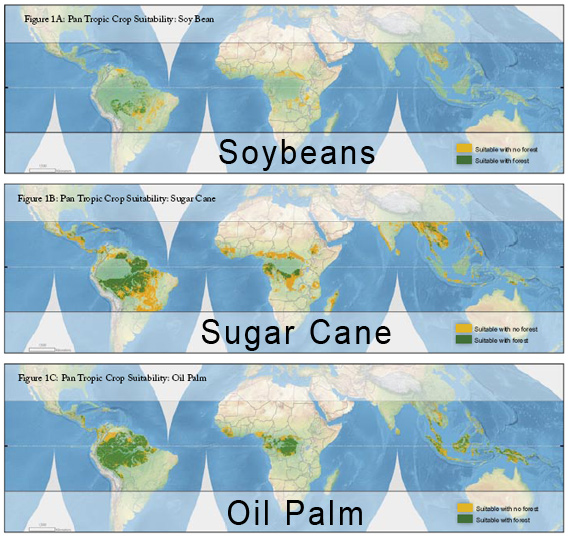Tropical forests face huge threat from industrial agriculture
Tropical forests face huge threat from industrial agriculture
mongabay.com
December 5, 2007
With forest conversion for large-scale agriculture rapidly emerging as a leading driver of tropical deforestation, a new report from the Woods Hole Research Center (WHRC) suggests the trend is likely to continue with Brazil, the Democratic Republic of the Congo, Indonesia, Peru, and Colombia containing 75 percent of the world’s forested land that is highly suitable for industrial agriculture expansion. Nevertheless the study identifies forests that may be best suited (low population density, unsuitable climate and soils) for “Reduced Emissions from Deforestation and Degradation” (REDD) initiatives which compensate countries for preserving forest lands in exchange for carbon credits.
“Forests with low suitability of industrial agriculture and low densities of human residents will be the cheapest to set aside as nations develop their REDD programs,” states a release from WHRC.
The study, titled “Readiness For Redd: A Preliminary Global Assessment Of Tropical Forested Land Suitability For Agriculture”, shows that in some countries (Bolivia, Congo, Venezuela, Guyana) one third to one half of the forests are unsuitable or have low concentrations of farmers, making them priorities for protection within REDD programs. The report also notes that in some countries (Malaysia, French Guiana, Cameroon) virtually all forested lands have high agricultural potential or high population densities.
The assessment shows that Brazil has 390,000 square kilometers of forested land suitable for soy, 2.283 million sq km for oil palm, and 1.988 million sq km for sugar on lands that combined contain 49 billion tons of carbon. Congo DRC has the potential to convert 1.015 million sq km of forest for industrial agriculture, including 778,000 sq km for oil palm plantations. Indonesia (765,000 sq km — 617,000 sq km suitable for oil palm), Peru (513,000 sq km — 458,000 sq km suitable for oil palm), Colombia (438,000 sq km — 417,000 sq km suitable for oil palm), Venezuela (270,000 sq km — 157,000 sq km suitable for sugar cane), and Malaysia (193,000 sq km — 146,000 sq km suitable for oil palm) follow.
 Tropical land area suitable for soy (a), sugar cane (b), and oil palm (c). Areas in dark green are suitable for the individual crop and are currently forested, areas in yellow are suitable for the individual crop and currently not forested. Forest and non-forest regions are defined by the Vegetation Continuous Fields dataset (Hansen et al., 2001). |
Claudia Stickler et al (2007). Readiness For Redd: A Preliminary Global Assessment Of Tropical Forested Land Suitability For Agriculture [PDF]. The Woods Hole Research Center. United Nations Framework Convention on Climate Change (UNFCCC) Conference of the Parties (COP), Thirteenth session. 3-14 December 2007
Recent articles on palm oil
Carbon offset returns beat forest conversion for agriculture in Indonesia
(11/21/2007) Conversion of forests and peatlands for agriculture in Indonesia has generated little economic benefit while releasing substantial amounts of greenhouse gases into the atmosphere, reports a new study from the the World Agroforestry Centre (ICRAF), the Center for International Forestry Research (CIFOR) and their Indonesian partners.
Oil palm does not store more carbon than forests
(11/8/2007) Officials from the Indonesian ministry of agriculture and the palm oil industry are distributing materials that misrepresent the carbon balance oil palm plantations, according to accounts from people who have seen presentations by members of the Indonesian Palm Oil Commission. Ministry of agricultural officials are apparently arguing that oil palm plantations store and sequester many times the amount of CO2 as natural forests and therefore converting forests for plantations is the best way to fight climate change. In making such claims, these Indonesian officials are ignoring data that show the opposite, putting the credibility of the oil palm industry at risk, and undermining efforts to slow deforestation and reign in greenhouse gas emissions.
Carbon-negative bioenergy to cut global warming could drive deforestation
(11/6/2007) A proposed mechanism for generating carbon-negative bioenergy — an energy source that reduces atmospheric carbon dioxide levels — could drive large-scale deforestation in the tropics and undermine efforts to conserve forests for carbon offsets says a biofuel expert.
Biodiesel demand could destroy world’s forests
(10/4/2007) Growing demand for biodiesel could drive large-scale forest conversion for energy crops, warns a study published in Conservation Biology.
Environmentalists and palm oil producers should work together
(9/25/2007) Environmentalists and palm-oil producers are increasingly at odds. Greens groups say palm oil is driving the conversion of tens of thousands of hectares of peatlands and lowland forest in Indonesia, putting wildlife at risk, increasing the vulnerability of forests to fires, and triggering large emissions of greenhouse gases.
High oil prices fuel bioenergy push
(5/9/2006) High oil prices and growing concerns over climate change are driving investment and innovation in the biofuels sector as countries and industry increasingly look towards renewable bioenergy to replace fossil fuels. Bill Gates, the world’s richest man, has recently invested $84 million in an American ethanol company, while global energy gluttons ranging from the United States to China are setting long-term targets for the switch to such fuels potentially offering a secure domestic source of renewable energy and fewer environmental headaches.
High oil prices fuel bioenergy push
(4/25/2006) Recently much has been made about the conversion of Asia’s biodiverse rainforests for oil-palm cultivation. Environmental organizations have warned that by eating foods that use palm oil as an ingredient, Western consumers are directly fueling the destruction of orangutan habitat and sensitive ecosystems. So, why is it that oil-palm plantations now cover millions of hectares across Malaysia, Indonesia, and Thailand? Why has oil palm become the world’s number one fruit crop, trouncing its nearest competitor, the humble banana?